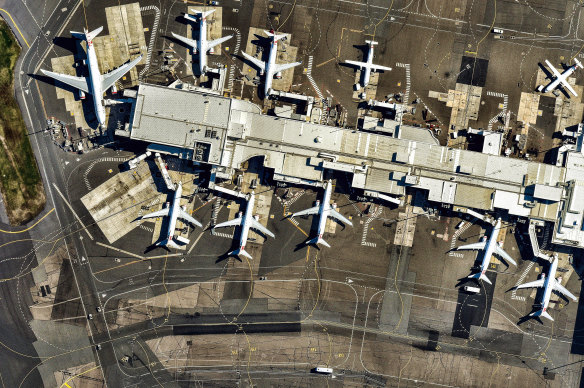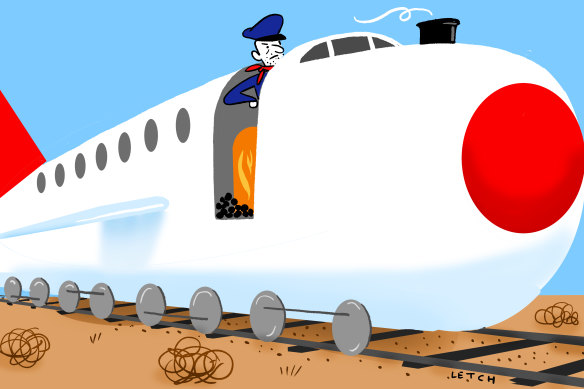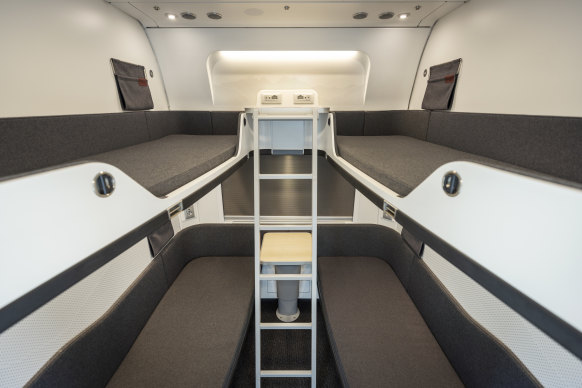Opinion
The Sydney-Melbourne route is one of the world’s busiest. It’s also hellish
Anthony Dennis
Editor, travelWhen the “world’s busiest domestic flight paths” annual survey was first released years ago listing the Sydney-Melbourne-Sydney corridor as one of the five busiest, the news was received with a similar pride to that we once felt for Australia’s airline system.
How impressive that a country of little more than 26.5 million people (a lot less back then) could make such a list?

Planes parked at Sydney Airport. The Sydney-Melbourne route is again one of the world’s busiest since air travel returned after pandemic restrictions ended.Credit: Getty Images
But that was then and this is now. Let’s not kid ourselves. Australia now suffers from not only a well-documented tyranny of distance but also an increasingly evident tyranny of transportation.
Flying on this duopolistic corridor is now often a deflating, expensive and fraught undertaking, especially during the route’s busiest periods.
In fact, it may well be on its way to being the next worst thing to flying domestically in the US.
Of course, it’s long been a rule of thumb that the real time needed to travel between Melbourne and Sydney is not that seemingly convenient one-hour-or-so flight but an ordeal which can involve a total, if you’re lucky, of at least five hours door-to-door. Now it can be much longer, or at least feel as though it is.
Not only is that a bad outcome for the harried passenger, it also adds up to a potential massive loss of productivity, especially when you consider that our airlines seem unable to supply passengers with what is now almost an essential: reliable inflight Wi-Fi.
Meanwhile, as Melbourne, with its comparatively distant airport, waits and waits for an airport rail link, Sydney has had to settle with a less than world-class version. In truth, Sydney’s airport train line is a glorified everyday suburban commuter service that happens to pass beneath the airport terminals.
Taxis have become so expensive between Tullamarine and the Melbourne CBD some companies have implored employees to take the cheaper SkyBus.

VST.Credit: Simon Letch
Back in Sydney, there’s also a problem, documented on social media and by bitter personal experience, of taxi drivers being reluctant or unwilling to take passengers on journeys they consider too short a distance or, if they do agree, grumbling all the way.
But back to that latest flight routes report, compiled by UK-based OAG, a global travel data provider.
It puts only Jeju-Seoul, Sapporo-Tokyo, Fukuoka-Tokyo and Hanoi-Ho Chi Minh City ahead of Australia’s two biggest and most important aviation hubs.
All of those Asian routes service huge numbers of international and domestic tourists that dwarf the numbers of inbound visitors to Australia.
Of course, the principal reason that Sydney-Melbourne-Sydney features so prominently on the list each year is largely due to the refusal of governments to invest not only in sustainable high-speed rail but in rail of any reasonable or acceptable speed and comfort (to be fair, Vietnam is also lagging in this area).
Interestingly, no European cities feature in the OAG’s top 10 list. The reason? The continent is exceptionally well-serviced with not only eco-friendly, fully electrified bullet trains but also with other passenger trains which are not quite as fast, but are perfectly quick enough.

One of Europe’s next generation Nightjet trains.
Europe’s increasingly popular Nightjet train service transports passengers overnight in comfort, including in sleeping compartments, between the true centres of major cities and can reach speeds of up to 230km/h (compared to 320km/h achieved by France’s TGV).
In Australia, the interstate train between Sydney-Melbourne-Sydney operates at a top speed of 160 kilometres – if it ever reaches such levels.
We can’t as a nation even offer a reasonably speedy train between Sydney and Canberra, a distance of only 300 kilometres, with the ACT being one of just a few Western national capitals not adequately serviced by rail.
The total travel time by train between Sydney and Canberra can be almost five hours, compared to three hours by road.
While the rest of the world– even the US – re-embraces rail, and in the case of a forward-looking France, bans domestic flights of under 2.5 hours in favour of trains, it was recently announced that the operators of the Sydney-Melbourne-Sydney train service are withdrawing sleeping compartments.
It’s argued that a convincing business case for a VFT (Very Fast Train) doesn’t exist but even a QFT (Quite Fast Train) would suffice, or at least a much improved experience of flying between Sydney and Melbourne. Then there’s that now seemingly defunct esprit de corps known as nation building.
A lack of world-class trains aside, the matter of chronic flight delays (or, worse, cancellations) doesn’t only affect passengers who are stuck aboard waiting aircraft.
It burdens those who have to contend with crowded and poky departure lounges with inadequate seating, a particular problem at the Virgin Australia section of Sydney’s T2 domestic terminal.
One of those “bear with us while we improve your terminal experience” hoardings was still up late last year inside Sydney’s T2 as the airport’s operators added, among other “improvements”, a sprawling retail outlet. But there is still no sign of any apparent enhancement of the inadequate departure gate conditions.
Not even the premium class lounges of our domestic airlines (you know, the ones with those teeny plates that are an obvious measure to thwart enthusiastic members of the pile-high club) offer much solace.
At their busiest, they are not much better than pubs with Wi-Fi and charging outlets, if you can find an available one.
Alas, Australia, where the word “infrastructure” is suddenly now a pejorative rather than an overture for politicians, will continue to suffer from the tyrannies of both distance and transport as it’s considered we have too small a population to justify a VFT (or a QFT, for that matter) between Sydney and Melbourne.
So, we’d all best brace ourselves as it looks like it’s going to be a long time before our two biggest cities drop out of that world’s busiest flight routes list or the process of travelling on it improves.
It all means that the next time we fly between Sydney and Melbourne, or vice versa, we’ll just need to drown our collective sorrows in the spirits section of that new retail behemoth.
Anthony Dennis, editor of travel at The Sydney Morning Herald and The Age, flies regularly between Melbourne and Sydney.
Sign up for the Traveller newsletter
The latest travel news, tips and inspiration delivered to your inbox. Sign up now.